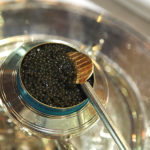 As a half-Japanese American, salty preserved fish products are in my blood. I grew up eating tarako, the salted, cured roe of Alaskan pollock, served inside rice onigiri or grilled up for breakfast. But it wasn’t until I started working at fancy-pants restaurants that I first tasted real Ossetra caviar
As a half-Japanese American, salty preserved fish products are in my blood. I grew up eating tarako, the salted, cured roe of Alaskan pollock, served inside rice onigiri or grilled up for breakfast. But it wasn’t until I started working at fancy-pants restaurants that I first tasted real Ossetra caviar
The first bite I had was a small dollop of Iranian osetra that I ate off of a plastic spoon the chef handed me in the walk-in refrigerator. Subtly salty with a distinct minerality and an aroma of the sea. The beads of sturgeon roe rolled across my tongue, popping against the roof of my mouth in little saline bursts. It was mind-blowing stuff, and I relished every opportunity to work with it and taste the many varieties available
Caviar is technically the salted roe of sturgeon, a prehistoric, scale-less fish that ranges in the Northern hemisphere from North America to China. At the market, you’ll also find cured eggs from other fish that are occasionally referred to as caviar, but their labeling will always indicate the type of fish they came from, such as “American spoonbill caviar” or “Salmon caviar.” Depending on the species of sturgeon, area of harvest, and treatment of the eggs after harvest, caviar can vary in texture, flavor, and appearance
What was once largely a wild-harvested product is now largely farm-raised. During the Soviet era, the harvest and production of wild caviar was a tightly controlled, highly lucrative industry in the Caspian and Black seas. But this all changed with the dissolution of the USSR—everybody wanted a piece of the pie. The ensuing over-fishing of sturgeon has been devastating to the ecosystem and the industry. The sale of Beluga caviar—the most highly prized of the three most famous sturgeon species—has been banned by the United States Fish and Wildlife Service since 2005. Wild osetra sturgeon have likewise been harvested to near extinction. Their caviar is currently unavailable.
These days, most of the caviar available in the U.S. comes from farmed fish around the world—the United States, China, and Israel being some of the largest producers. So what does this new market look like, and more importantly, how can you buy it with confidence?
We sat down with Alexandre Petrossian, 30, the third generation Vice President of Petrossian, to talk about the salty fish eggs. The famed Paris caviar house has an online boutique as well as a shop and restaurant in New York. “They say that good caviar should have at least 15 different flavors in it,” he starts. “Each time you take a bite, you should taste something new. It should develop on your tongue and the aftertaste should linger for a very long time.”
“Surprisingly, the Chinese farms are some of the best,” he says. Petrossian currently offers several varieties of Chinese caviar, including their Imperial Shassetra and Kaluga, which is amongst the more expensive in their line-up. “They actually came to us before they started designing the farms, asking for details about every step of the process, and how we like our caviar to be raised and harvested. They were really determined to do it right.” Because of this, the Chinese caviar is among the most consistent.
I brought back five tins of sturgeon caviar to Serious Eats World Headquarters where we had a blind tasting. The caviars ranged in price from $113 to $481 per 50-gram tin. But our favorites were not the most expensive. Take a look at our tasting notes in the slideshow above.
“Good caviar should have distinct eggs that separate when you roll them on the roof of your mouth,” says Alexandre. “They need to pop,” rather than taste mushy. When you open a tin, the caviar should be shiny, each egg glistening, not oily or murky. “Good caviar sparkles like diamonds,” says Alexandre. “It makes it quite difficult to take photographs.”
- How To Taste And Serve Caviar
The traditional accompaniments to caviar are Champagne or ice-cold vodka. “Avoid a heavier red or white wine with caviar,” advises Alexander. “It will compete with the flavor.” If tasting a variety of different caviars, drink water or sparkling water between varieties to cleanse your palate.
I prefer to taste caviar straight out of the tin using a spoon. Mother-of-pearl is pretty and the traditional choice, but you don’t need a fancy spoon to eat it. “I taste my caviar from a wooden spoon because that’s how I was taught to taste it growing up,” says Alex. I like to use plastic spoons. The only material to avoid is silver, which can react with the caviar to give it a metallic flavor

Be the first to comment on "Serious Eats Guide: How to Osetra caviar"